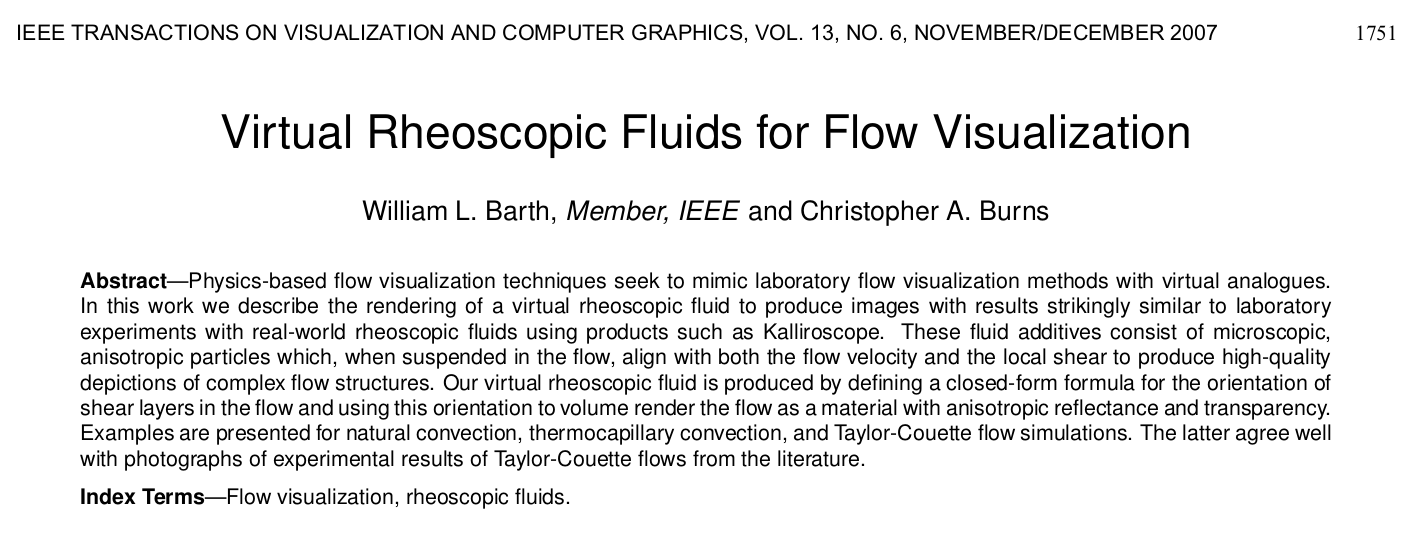A literate Lattice Boltzmann Code
Adrian Kummerländer
What?
Literate Programming
…a tool for reproducible science.
Instead of imagining that our main task is to instruct a computer what to do, let us concentrate rather on explaining to human beings what we want a computer to do. —Donald Knuth (Literate Programming, 1984)
Setup
LiterateLB Features
- Self contained
- (Smagorinsky) BGK collision
- Workable set of boundary conditions
- Integrated (volumetric) visualization
- Interesting set of examples
- Competitive GPU performance
Visualization
- Useful both for science and art
- Just in Time vs. Real Time
- Inspired by reality and freed from its restrictions
Signed Distance Functions
- \(d : \mathbb{R}^3 \to \mathbb{R}\) is shortest distance to surface
- Iteratively approximate directed distances
- Surface normals
- Model for boundary configuration and visualization
Constructive Solid Geometry
- library of geometric primitives
- combine with boolean operators
v = translate(v, center);
return ssub(
rounded(box(v, v3(20, 20, 20)), 5),
sphere(v, 25),
5
);
Fancy example
add(
sadd(
sub(
rounded(box(v, v3(5, 28, 38)), 1),
rounded(box(v, v3(6, 26, 36)), 1)
),
cylinder(translate(v, v3(0,0,-45)), 5, 12),
1
),
sintersect(
box(v, v3(5, 28, 38)),
add(
add(
box(rotate_x(v, angle), v3(10, width, 100)),
box(rotate_x(v, -angle), v3(10, width, 100))
),
add(
add(
add(
box(rotate_x(translate(v, v3(0,0,25)), angle), v3(10, width, 100)),
box(rotate_x(translate(v, v3(0,0,25)), -angle), v3(10, width, 100))
),
add(
box(rotate_x(translate(v, v3(0,0,-25)), angle), v3(10, width, 100)),
box(rotate_x(translate(v, v3(0,0,-25)), -angle), v3(10, width, 100))
)
),
add(
add(
box(rotate_x(translate(v, v3(0,0,50)), angle), v3(10, width, 100)),
box(rotate_x(translate(v, v3(0,0,50)), -angle), v3(10, width, 100))
),
add(
box(rotate_x(translate(v, v3(0,0,-50)), angle), v3(10, width, 100)),
box(rotate_x(translate(v, v3(0,0,-50)), -angle), v3(10, width, 100))
)
)
)
),
2
)
);
Sphere tracing
Volumetric Visualization
Ray Marching
- Common practice for volume rendering
- Periodically sample some scalar value along a ray
- … velocity norm, density, curl magnitude, shear layer visibility, various quality criteria …
- Discretized volume rendering equation
- Extensible to arbitrarily complex light transport
Volume rendering equation
Color \(C\) along ray \(r\) with length \(L\) with absorption \(\mu\): \[C(r) = \int_0^L c(x) \mu(x) \exp\left(-\int_0^x \mu(t) dt\right) dx\]
Simplified for speed: \[C(r) = \sum_{i=0}^N C(i \Delta x) \alpha (i \Delta x) \prod_{j=0}^{i-1} \left(1 - \alpha(j\Delta x)\right)\]
Color palette
- Can make or break a good visualization
- SciVisColor.org offers a variety of useful palettes
- LiterateLB includes a selection of them


Virtual Rheoscopic Fluid

\(n_\text{shear} = 2 D u \hat{u} - 2\left(u^T D u \hat{u} \right) \hat{u}\)
Shear Layer Normal
- fuid stress tensor \(\sigma\), strain-rate tensor \(Du\)
- \(R_{\hat{u}} = \sigma \hat{u}\) force on infinitesimal plane in flow
- \(R_{\hat{u}} - (R_{\hat{u}} \cdot \hat{u}) \hat{u} = 2\mu Du\hat{u} - 2\mu(\hat{u}^TDu\hat{u})\hat{u}\)
- Neglect viscosity scalar \[n_\text{shear} = 2 D u \hat{u} - 2\left(u^T D u \hat{u} \right) \hat{u}\]
- Construct strain-rate tensor from \(f^\text{neq}\)